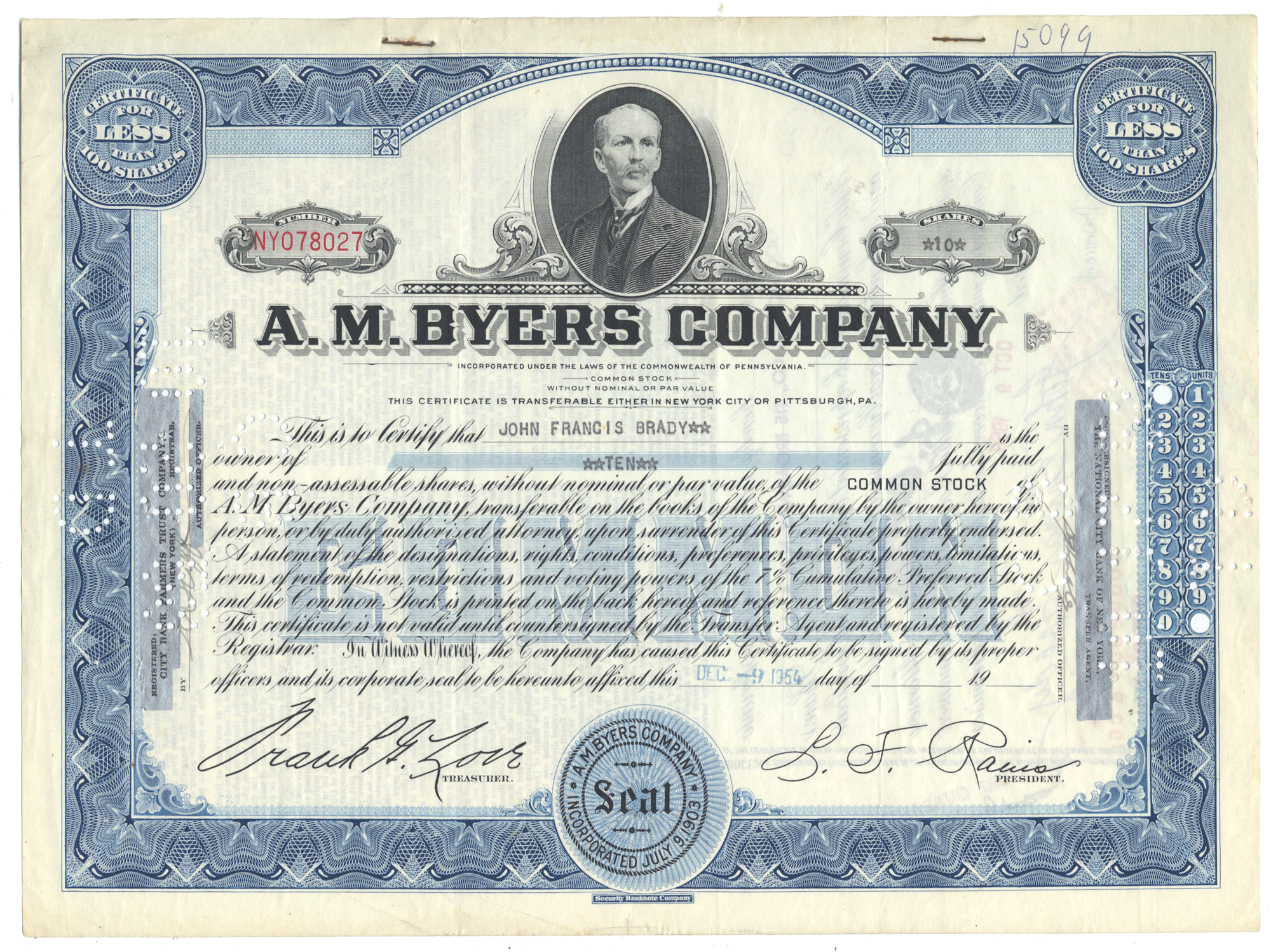
Columbia & Puget Sound Railroad Company
- Guaranteed authentic document
- Orders over $75 ship FREE to U. S. addresses
Product Details
Company
Columbia & Puget Sound Railroad Company
Certificate Type
Capital Stock
Date Issued
April 21, 1906
Canceled
Yes
Printer
Not indicated
Signatures
Hand signed
Approximate Size
9 3/4" (w) by 7" (h)
Images
Show the exact certificate you will receive
Guaranteed Authentic
Yes
Additional Details
NA
Historical Context
Henry Villard purchased the Seattle and Walla Walla Railroad and the Newcastle Mine in 1879. To consolidate these and other holdings around Puget Sound, Villard created the Oregon Improvement Company in October 1880. The OIC purchased the Seattle & Walla Walla Railroad (including the Seattle Coal & Transportation Co.), the Franklin coal mine and the town of Franklin. Consolidation of these companies gave Villard extensive control over the coal deposits in the Newcastle region. On November 26, 1880 the deal was complete, and the S&WW was reincorporated it as the Columbia and Puget Sound Railroad.
He envisioned the Columbia and Puget Sound Railroad and his Oregon Railway & Navigation Company as the final leg of the Northern Pacific Railway’s transcontinental expansion. When Villard offered the connection to Northern Pacific, the board refused his offer. In retaliation he orchestrated a “Blind Pool” buyout to gain control of the company. After successfully purchasing 60% of the company stock, he became the president of the railroad in September 1881.
He also assumed the railroad's transcontinental obligations and announced that he would complete the link between St. Paul and Tacoma within two years. He promised Seattle's citizens that he would extend the line north to their city, even though Tacoma remained the official western terminus. Seattle’s City Council gave the OIC development rights to a mile-long, 30-foot-wide strip of land running north along the waterfront from King Street to Clay Street just south of Broad Street. The two new docks would be known as the City Dock, lying between Washington and Main streets, and the Ocean Dock, just to the north between Main and Jackson. There the trains of Villard's Columbia & Puget Sound Railroad would meet the ships of the Oregon Railroad & Navigation Company.
Years of expansion took their toll on the financially strapped Northern Pacific. When revenue did not materialize as planned, Villard's companies crashed financially. Villard’s lawyer, William Nelson Cromwell settled with creditors for $1,000,000. Humiliated, Villard resigned from the presidency of the Northern Pacific Railroad in January 1884. The new President of the Northern Pacific, Charles B. Wright, announced that Tacoma would be the railroad's terminus. The planned mainline into Seattle would be left to branchline service. The first standard gauge train entered Seattle on June 17, 1884.
In 1889, the City and Ocean docks were destroyed in the Great Fire, and along the entire waterfront south of University Street. The Oregon Improvement Company soon built larger facilities on the ruins, which would be designated Docks A and B. They were eventually replaced by Pier 48, built in the mid-1930s and currently operated the Port of Seattle in 1950.
Both the Northern Pacific Railway and Oregon-Washington Railroad constructed their own lines into Seattle in by the end of the 19th century. The Oregon Improvement Company missed a bond payment in October 1895 and was forced to declare bankruptcy. The OIC was reorganized as the Pacific Coast Company in 1897. The town of Black Diamond and the coal mines were sold to the Pacific Coast Coal Company, a wholly owned subsidiary of the Pacific Coast Company, in 1904.
The Chicago, Milwaukee, St. Paul and Pacific Railroad (The “Milwaukee Road”) entered the Maple Valley in 1906 and entered an agreement with the C&PS for trackage rights over over 20.4 miles through Maple Valley. This agreement remained in place until the Milwaukee Road abandoned it's Pacific Extension in 1980.
On February 23, 1916, this company was renamed the Pacific Coast Railroad Company. Not to be confused with the Pacific Coast Railway Company of California, which was also owned by Pacific Coast Company. By the late 1930s financial soundness of the Pacific Coast Company was in trouble. The branches serving the coal mines were gradually removed through the first half of the 20th century. Operation on the Newcastle Branch ceased in 1933. The branch was abandoned completely in 1935.
What remained of the Pacific Coast Railroad became a Great Northern subsidiary in 1951 and purchased the railroad in 1952. On March 2, 1970 the Pacific Coast Railroad became part of Burlington Northern on March 2, 1970 and subsequently the Burlington Northern Santa Fe on December 31, 1996.
Related Collections
Additional Information
Certificates carry no value on any of today's financial indexes and no transfer of ownership is implied. All items offered are collectible in nature only. So, you can frame them, but you can't cash them in!
All of our pieces are original - we do not sell reproductions. If you ever find out that one of our pieces is not authentic, you may return it for a full refund of the purchase price and any associated shipping charges.





